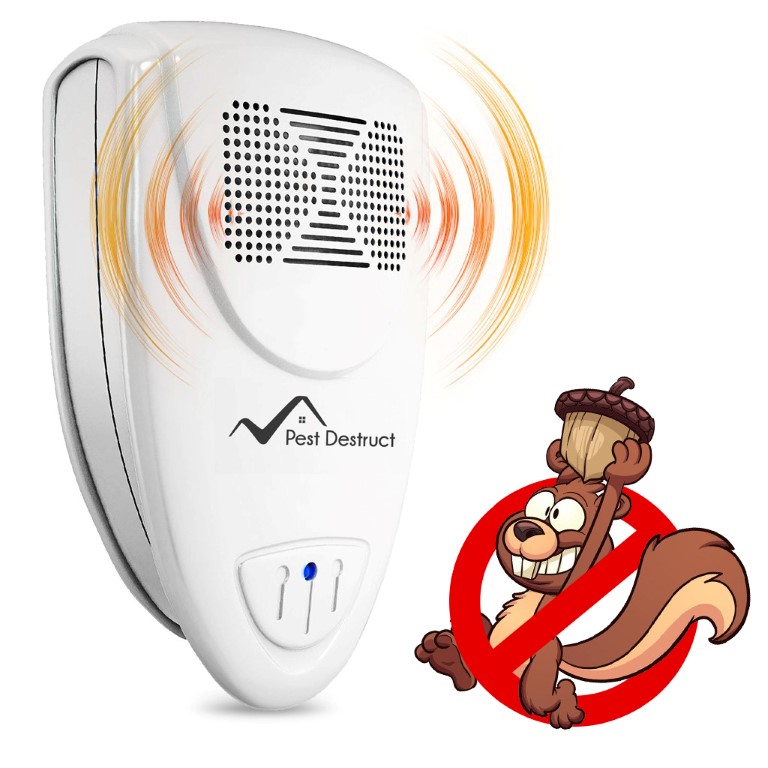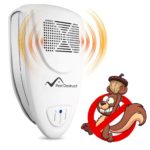
If you’ve got squirrels in your attic, ceiling, or crawlspace- don’t despair. Even if you’ve already tried making them leave by using mothballs or traps, there is a better, simpler way. Before we get to that, however, you need to be committed. Yes, squirrels and generally considered adorable, but you must not, under any circumstances, let them live in your attic. Why? Read on.
UPDATE: Pest Destruct is offering a special 50% DISCOUNT
Discount link: Ultrasonic Squirrel Repeller Special Offer – ONLY $29.97
Why You Must Remove the Squirrels as Soon as Possible
There are three main reasons you need to oust your new attic tenants as soon as you can. First, they can bring unpleasant, potentially disease-harboring insects into your home. Second, they will bring more squirrels to their new found haven. Third, squirrels do not belong in houses and will cause damage to yours.
Squirrels Can Bring Parasitic Insects – Squirrels in your attic aren’t all that likely to spread disease but they can infest your home with fleas and, potentially, bring a few ticks inside as well. In order to get rid of the fleas, you’ll have to get the squirrels out too, just treating for fleas will result in recurrent infestations.
You Do Not Have Just One Squirrel – The chances that there is just one squirrel in your ceiling or attic are fairly low. Squirrels are social, family-oriented creatures. Even if there’s just one there now, there are likely as many as a dozen more than know how to get inside- and that’s if your infestation has only just begun.
One of the main reasons squirrels take refuge in a house, be it a crawlspace or an attic, is that they are looking for a place to nest. Once a nest is built, maybe as it’s being built, they’re going to have babies. Those baby squirrels, while harmless, won’t be able to move on their own for 6 to 8 weeks.
Once you have a nest full or squirrel babies, typically four on average, you will need professional help if you want to take care of the situation humanely. That means either hiring a professional to take the nest away, babies and all, or taking the nest to a wildlife rehab organization yourself. Your local humane society may also be able to help.
Squirrels Can Damage the Structure of Your Home – While not as destructive as other rodents like rats and mice, squirrels some with their own particular destructive traits. Squirrels like to pull up fibrous insulation creating an uneven distribution. They may also accidentally break wires, leading to a fire hazard and potential loss of power.
As far as damage to beams and the ceiling or roof itself, squirrels may gnaw and dig to create new exits or entrances, but the real problem is the mess they make just by living up there. This can all lead to mold, damp patches, and similar problems.
Another potential fire hazard that should never be overlooked is what a squirrel can do to your chimney. If your chimney is uncapped, or there is an access point to it in the attic, never use it until the infestation is dealt with and your chimney has been inspected. Squirrels like to make nests in chimneys. This is one of the greatest fire hazards you or your household could face.
What Are the Signs of Having Squirrels?

If you’re reading this, you already suspect that you have attic squirrels but how can you be sure? The first and most obvious thing you will notice is the sound. While mice, rats, and other common rodents are active at night, squirrels and up and about during the day as well. They will create noise, seemingly, 24/7. These sounds may be from running, scratching, chewing, and even fighting if you have multiple families vying for the same territory.
Further, obvious signs of damage are your second clue. Larger holes than mice create, exposed or frayed wires and nesting materials (typically of the fibrous variety or kindling) are all common signs. Squirrels also have a distinct, hard not to notice smell that marks their territory and nesting areas.
The Easiest Solution to Your Attic Squirrel Problem
Now that you know the importance of getting those squirrels out now, no matter how harmless they might seem, it’s time to learn the best solution to your problem. That solution is to acquire and install a high-quality pest repeller like this Ultrasonic Squirrel Repeller.

This small device emits a sound that squirrels and other rodents can hear, but humans can’t. By placing one or two of these in your attic, depending on its size (one is usually sufficient), the squirrels will leave on their own, usually in no more than a day. Why? Because these repellers are intolerable for the squirrels. The sounds they emit are very irritating. Further, this solution comes with a host of other advantages.
- Ease of Use – The ultrasonic pest repellers are incredibly easy to use. Just plug them into the wall or the socket of an extension cord (if your attic isn’t wired). Set them up as near to where the squirrels have set up camp as possible. Even if there is already a nest with small baby squirrels, the mother squirrel will move her young, given enough time.
- Humane – Ultrasonic devices don’t hurt the squirrels in any way- they’re just very, very annoying. If you compare this to traps and poison, these ultrasonic repellers are better by a mile. No pain, no suffering for the squirrels and no handling the squirrels for you.
- Safe for Everyone – Ultrasonic pest repellers use sound to deter rodents, including squirrels, and other pests. They’re no more harmful to you, children, or your pets than a radio would be. If, however, you happen to have small pets, like rabbits or hamsters, it’s best to keep them in a room on a lower floor, away from the attic or a few rooms away from where the repeller is. Though the sounds are harmless, they may still be irritating to small pets.

- Relatively Inexpensive – When you compare these Ultrasonic Squirrel Repellers to any other solution for attic squirrels, their cost alone can’t be beaten. While poison should never be used on squirrels, “squirrel poison” as it is marketed, will cost nearly as much as a single repeller, and the repeller can be used over and over again. By that same token, traps will cost you nearly double what one ultrasonic device does, and scent repellents are, well, just less effective. If you want to get rid of your attic squirrels now, for the least cost, time, and trouble, these ultrasonic pest repellers are the only way to go.
- Reliable – The only other “solution” to an attic squirrel infestation is to set up a series of fairly complex traps and wait for the squirrels to leave. That can take weeks and it’s not guaranteed to work- if you overlook a weak spot or gap in your attic, the squirrels won’t stop coming and going. With these repellers, you’re covered no matter what. Better, the ones from Pest Destruct comes with an outstanding guarantee- if your attic squirrels aren’t gone in 7 days or less, the ultrasonic repeller is free. That’s how confident the makers of this product are that it will solve your problem in a timely manner.
How to Keep the Squirrels from Coming Back
Once you’ve managed to oust the squirrels from your attic you need to get to work shoring the place up. Yes, the repellers should keep squirrels and other pests from creating more nests up there, but you shouldn’t leave the place open to pests and the elements.

If you have a chimney, invest in a squirrel-proof chimney cap. If you have vents in your attic or roof, check to make sure none of them are damaged, replace them if they are, and upgrade any grating to a smaller size if it seems substandard. Above all, check every inch of the walls and ceiling for potential access holes. Seal them off with metal mesh to prevent the squirrels from making their way back in.
Remember, squirrels can go through holes as small as 1.5 inches in diameter, even if it doesn’t seem likely, these creatures are surprisingly squishy. Gaps around pipes and vents are popular targets as a little chewing usually gives them a good-sized access point. Seal these areas well.
A Few Things to Keep In Mind When Dealing with Attic Squirrels
Once you have a plan, there are a few additional things to keep in mind. First and foremost is to make sure the squirrels are actually gone before you close off all the exits. If the main nest is gone and noise from the activity is unnoticeable, you’re probably okay. However, if the nest is “gone” but the sounds of activity remain, it may have been moved. In cases like this, you may have to adjust your repellers for better coverage, especially if you have a large or finished attic.
If you plan to use traps in addition to repellents in order to catch the squirrels as they leave, make sure to release the squirrels as far from your home as possible. At a minimum, this should be five miles away. Ideally, it would be more than ten. However, if you seal up your attic after the ultrasonic devices have done their job, traps and relocation should be unnecessary.
Get Rid of Squirrels In 72 Hours Or It’s FREE!
Pest Destruct is a great company that offers mind-blowing guarantee… If you buy this Ultrasonic Squirrel Repeller and still have squirrels in your house 72 hours after applying it, you’ll get your money back and keep the device! Your satisfaction is 100% guaranteed! Buy the Ultrasonic Squirrel Repeller today!
